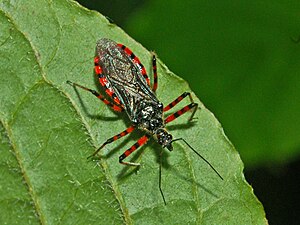Sphedanolestes cingulatus
| Sphedanolestes cingulatus | ||||||||||||
|---|---|---|---|---|---|---|---|---|---|---|---|---|

Sphedanolestes cingulatus |
||||||||||||
| Systematics | ||||||||||||
|
||||||||||||
| Scientific name | ||||||||||||
| Sphedanolestes cingulatus | ||||||||||||
| ( Fever , 1864) |
Sphedanolestes cingulatus is a species of bug from the family of predatory bugs (Reduviidae).
Distribution and habitats
The range of the bug species is limited to Italy (including Sicily). It is rare in northern Italy, more common in southern Italy and Sicily. The bugs are mainly found in the herb layer .
features
The bugs of the species Sphedanolestes cingulatus reach body lengths of 10 to 12 millimeters. They are tall and sturdy and almost completely black in color. The connexive (part of the abdomen visible on the side) is black with red spots. Sphedanolestes cingulatus has strong femora (thighs), which, in contrast to Sphedanolestes sanguineus, have three red and three black rings.
Way of life
The animals feed exclusively on various insects in a predatory manner.
etymology
The species name cingulatus is derived from Latin and means "belted" - referring to the color pattern of the legs.
Web links
- Sphedanolestes (Sphedanolestes) cingulatus (Fever 1864) in Fauna Europaea. Retrieved December 15, 2016
- www.entomologiitaliani.net - photo
literature
- STICHEL W. 1959: Illustrated identification tables for bedbugs. II. Europa (Hemiptera-Heteroptera Europae). 3. 6. Cimicomorpha, Reduviidae, Nabidae. W. Stichel, Berlin, pp. 81-206.
- PUTSHKOV PV & MOULET P. 2010: Hémiptères Reduviidae d'Europe occidentale. Faune de France and regions limitrophes. Vol. 92. Fédération Française des Sociétés de Sciences Naturelles, Paris, 668 pp. + 24 pls.
Individual evidence
- ↑ insectoid.info
- ↑ a b c d Paride Dioli, Ricercatore (Entomologia gen., Heteroptera: sistematica, biogeogr. & Biodiversità) - Museo Storia Naturale di Milano: Sphedanolestes cingulatus . www.naturamediterraneo.com. Retrieved January 19, 2017.
